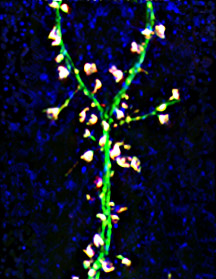

A Protein That Affects the Shape of Neurons
By Jason Socrates Bardi
A century ago, much of the cutting-edge research in mental health was directed at understanding the psychological basis of psychiatric diseases: how memories and experiences play a role in our mental states. From this research emerged behavioral therapy, Freudian analysis, group therapy, and many other techniques that have been successfully applied to the treatment in the field of mental health.
Today, as we understand more and more about how the human body and the brain work on the cellular and molecular level, there is more interest than ever in the physiological basis for psychiatric diseases—the systems of interacting molecules and the chemical mechanisms through which these diseases manifest themselves.
The reason for this interest is simple: there is an overwhelming need. According to the National Institute of Mental Health, over one fifth of all Americans, more than 44 million individuals, suffer from a diagnosable mental disorder in any given year.
Now two scientists at The Scripps Research Institute are reporting a breakthrough in our understanding of the brain physiology that forms the basis for certain psychiatric diseases.
In a recent issue of the journal Neuron, Associate Professor Shelley Halpain, Ph.D., and Research Associate Barbara Calabrese, Ph.D., describe how a protein called MARCKS affects the shape of neurons, particularly the part of the neurons known as dendritic spines, which are essential for learning and memory.
In the paper, the researchers show that MARCKS is a key player in the brain that affects the shape of these critical parts of human neurons. The research suggests a potential link between the molecular mechanisms involving MARCKS and the synaptic dysfunction observed in neurological diseases.
"MARCKS has a profound effect on already established, mature neurons," says Halpain, who is a member of the Institute for Childhood and Neglected Diseases at Scripps Research.
Nature of Neuronal Activity Determined by Shape
While cells in living creatures have a wide variety of shapes, neurons are perhaps the most varied. Many bear no resemblance to the box-like shape of other cells that look so tidy under the microscope that they inspired Robert Hooke to coin the word "cell," several centuries ago to describe them.
Had Hooke been looking at neurons instead of cork sections, he might have come up with a different name. Neurons look more like Texas congressional districts gone wild—long and stretched-out, often covering much more ground than an ordinary cell. They do have a recognizable cell body, or soma, which contains the nucleus, but they also have incredibly elongated branching tendrils called dendrites.
In some neurons, these dendritic "processes" extend for hundreds of times the length of the cell body and are so highly branched that they make synaptic contact with thousands of other neurons in the brain—sometimes as many as 10,000 connections apiece.
Dendrites play a key role in the function of neurons for it is through these processes that neurons communicate with one another. All along dendrites are synapses, the sites of communication between neurons where signals are communicated from one neuron to another via chemicals called neurotransmitters that are released across a synaptic cleft.
Most synapses that use the amino acid glutamate as a neurotransmitter are characterized by the presence of a very small protrusion on the dendritic membrane called a dendritic "spine," which is about one micron long (one millionth of a meter).
It is in this spiny part of neuronal cells where the synapses are and where many of the processes believed to be essential for learning, memory, and other higher brain functions take place. The branching, spiny architecture of dendrites allows a single neuron to receive up to tens of thousands inputs from other neurons—the communication backbone that underlies every mental process that a person has.
Because dendritic spines are so central to mental functioning, it's no surprise they are associated with neurological and psychiatric diseases. In mental retardation and autism, for instance, the shape of the dendritic spines are different. Under a microscope, the dendritic spines of many mentally retarded people are longer and appear more immature.
One of the leading theories of the cause of some types of mental retardation is that this altered shape may be affecting what is known as synaptic plasticity—a process whereby dendritic spines undergo subtle changes in shape and sensitivity to neurotransmitters in response to synaptic activity. Altered synaptic plasticity may be one of the most fundamental problems that causes mental retardation.
In recent years, scientists have become increasingly aware of the possibility that a number of psychiatric and neurodegenerative diseases like Alzheimer's are also affected by synaptic changes brought about by spine morphology. The brains of schizophrenic patients or people suffering from mood disorders also show a reduced number of dendritic spines in the brain areas associated with these diseases.
This type of altered neuronal morphology is one of the primary interests of Halpain and her laboratory. She and her colleagues have been developing and applying tools to study how synaptic connections are formed during the development of an organism, for instance, and to what extent they are altered or lost in certain diseases."The hope is that by understanding the biology of destabilization we can improve upon therapies that restore synapses," says Halpain.
Not Enough MARCKS Makes Short Spines
One of the things that Halpain and her colleagues became interested in a few years ago is how the structure of the dendritic spines is physically regulated by proteins that control the cellular cytoskeleton—the rigid protein "skeleton" of the cell made up of clusters of actin filaments. After all, this cytoskeleton determines the shape of neuronal spines, so Halpain and her colleagues wanted to figure out what other molecules in the neuron regulate the clusters of actin filaments and thereby dendritic spine morphology.
This is what led Halpain and Calabrese to the protein MARCKS, which is an acronym for "myristoylated, alanine-rich C-kinase substrate." The relevant part of this name is the "CKS, which indicates that MARCKS is regulated by a protein called PKC (for "protein kinase C"), a protein that is itself known to affect the morphology of dendritic spines.
Previous studies reported that MARCKS is altered in the brains of Alzheimer's patients and suicide victims, and its expression is regulated by lithium, an established treatment for mood disorders.
These pieces of evidence suggested to Halpain and Calabrese that MARCKS is a key regulator of the actin cytoskeleton and plays a role in maintaining the shape and stability of dendritic spines. Wanting to see if that was the case, Halpain and Calabrese manipulated the levels of MARCKS in living neurons and observed the effect of this on the structure of the spines.
The first thing the scientists did was to knock down MARCKS levels in neurons using a technique called RNA interference. The technique involves delivering small pieces of double stranded RNA into a neuron. Once inside the neuron, these short sequences anneal to complementary regions of cellular RNA and trigger an intracellular response that specifically destroys the target RNA. By designing the short sequences to anneal to RNA that encodes MARCKS, they effectively silenced it.
Using sensitive time lapse microscopy, Halpain and Calabrese observed the effect of knocking down MARCKS on living neurons, which were sustained in a growth medium.
It turns out that knocking down MARCKS levels dramatically affects the shape of dendritic spines. Halpain and Calabrese observed a dramatic reduction in the number of spines on the neurons as well as a dramatic overall shrinkage of those that remained. Normally, smaller spines mean smaller presynaptic terminals, so that a reduction in the number and size of spines would reduce the number of functioning synapses.
Interestingly, when the scientists did the opposite experiment and "overexpressed" MARCKS in the neurons, they also saw a reduction in the number of spines. Surprisingly, those that remained were elongated—a physiology that has been observed in certain types of mental retardation—because adjacent spines became fused together.
The fact that MARCKS is critical for the maintenance and morphology of dendritic spines is significant because it means that MARCKS may also be a key player in and the synaptic dysfunction observed in neurological diseases—perhaps even that treatments for certain diseases can be created by designing therapeutics to modulate MARCKS or some of the molecules with which it interacts.
The article "Essential Role for the PKC Target MARCKS in Maintaining Dendritic Spine Morphology" by Barbara Calabrese and Shelley Halpain appears in the October 6, 2005 issue of the journal Neuron. See: http://dx.doi.org/10.1016/j.neuron.2005.08.027
Send comments to: jasonb@scripps.edu

"MARCKS has a profound effect on already established, mature neurons," says Associate Professor Shelley Halpain (right), pictured here with Research Associate Barbara Calabrese.

Dendritic arbor of a hippocampal neuron expressing mRFP-actin (red) and eGFP (green), co-stained for phalloidin to detect F-actin (blue), which highlights the dendritic spines.
